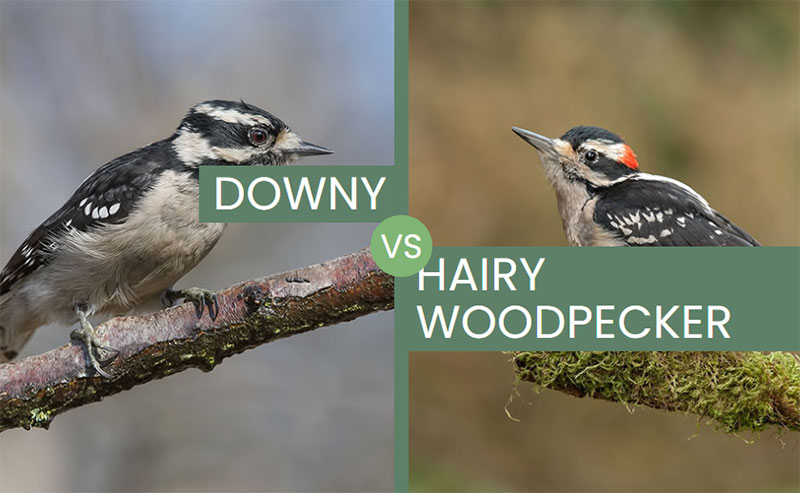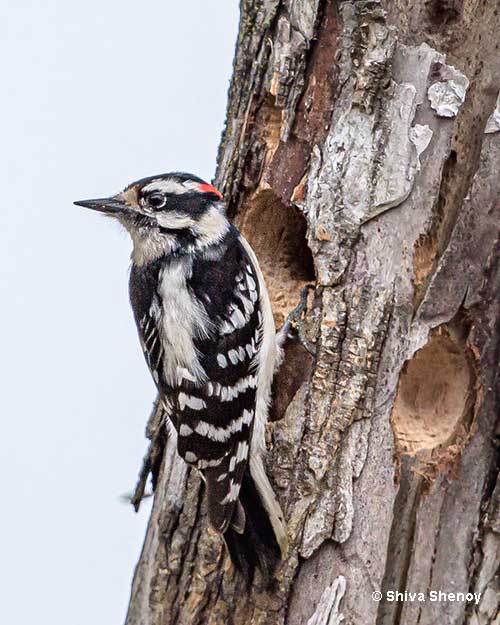Downy vs Hairy Woodpecker – they look similar at first sight, so at times, they can be difficult to tell apart.
Although the Downy Woodpecker is always smaller, since the perception of the size of a bird can be deceptive, we are better off focusing in on the bill.
The Downy Woodpecker has a small, short, dainty bill that accentuates its cute look. The Hairy Woodpecker, on the other hand, has a long, straight chisel of a bill that gives the bird more of a “non-nonsense” appearance.
On this page
Body & Shape
Downy and Hairy Woodpeckers have pretty similar body shapes. Both are Woodpeckers with strong, pointed beaks on rounded heads, medium to long wings, a medium-length tail with two elongated central tail feathers that help support the bird as it hitches up a tree trunk, and strong zygodactyl feet (two toes facing forward, and two facing backward).
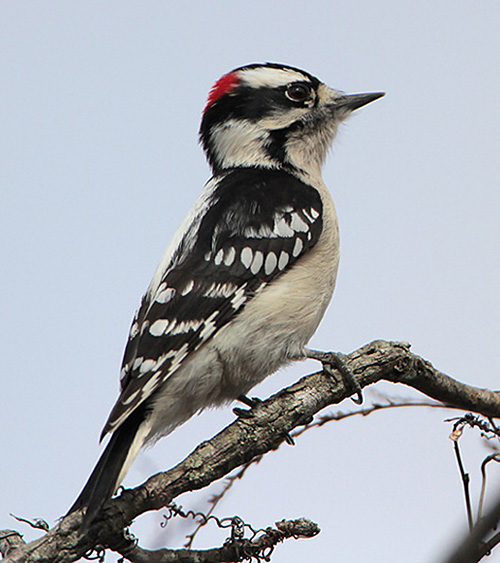
Downy Woodpecker. Photograph © Greg Lavaty.
However, the Downy Woodpecker has a much shorter bill, a plumper appearance, is smaller, and has slightly more rounded wings. Compared to the Hairy Woodpecker, it also seems to have a slightly shorter tail.
Plumages of these two species are very similar. Both Woodpeckers have black and white on the head, a big white patch on the back, a black rump, and a black tail with white outer tail feathers (and some black markings in the case of the Downy Woodpecker).
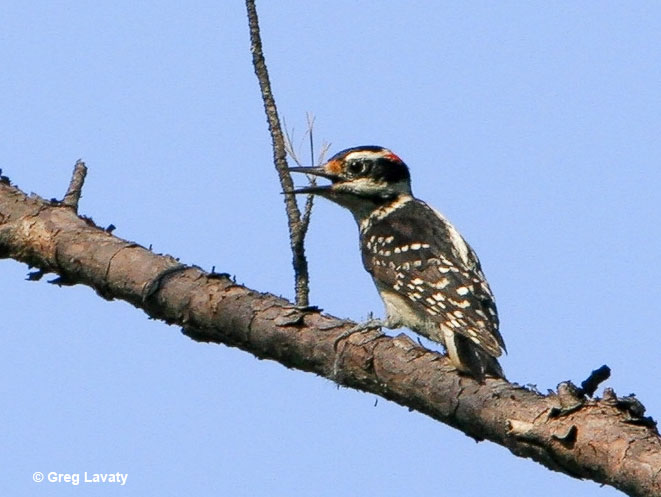
Hairy Woodpecker
These two species also have a small white area where the top of the bill meets the head (this white spot is more tufted in the Downy Woodpecker). They also have all white underparts, and black wings with white barring on the flight feathers and white spots in the shoulder of the wing.
Juveniles of both species have a bit of red on the top of the head, and adult males have a small red patch on the back of the head. Females lack this red patch.
Downy vs Hairy Woodpecker Size
The size difference between Downy and Hairy Woodpeckers is noticeable and an important factor for separating them from each other.
The average length and weight of the Downy Woodpecker is 6.75 inches and 27 grams, whereas Hairy Woodpeckers are 9.25 inches in length and weigh 66 grams.
The wingspan of the Downy Woodpecker is also 12 inches, while that of the Hairy Woodpecker is 15 inches.
If we compare their sizes to those of other bird species, we could say that the Downy Woodpecker is a bit bigger than a House Sparrow or around the same size as a White-throated Sparrow or Brambling, and the Hairy Woodpecker is a bit larger than a Northern Cardinal and nearly as big as an American Robin.
Speed
As with most Woodpecker species, neither the Hairy Woodpecker nor the Downy Woodpecker are known for fast flight. Both species usually fly for short distances between trees or patches of forest and might reach 20 miles per hour when chased by a hawk.
Both of these Woodpeckers also have a similar flight style of a few quick wing flaps followed by holding their wings closed for a second before making another burst of wing flaps and so on.
This results in a bounding or undulating flight pattern where the bird seems to bound up and down.
Neither species soars but when they approach a tree for landing, both Woodpecker species swoop up to the tree trunk. They can also quickly change direction and maneuver among tree trunks when attempting to escape a Sharp-shinned Hawk or other predator.
Downy vs Hairy Woodpecker Age
The average natural lifespan of a Woodpecker is believed to be 10 to 15 years. Some probably live longer but there have been very few studies investigating the lifespans of Woodpeckers.
All conclusions about their lifespans have come from the ages of the few banded birds that have been recaptured. In the case of the Downy Woodpecker, recaptured birds have been 9 and 11 years old.
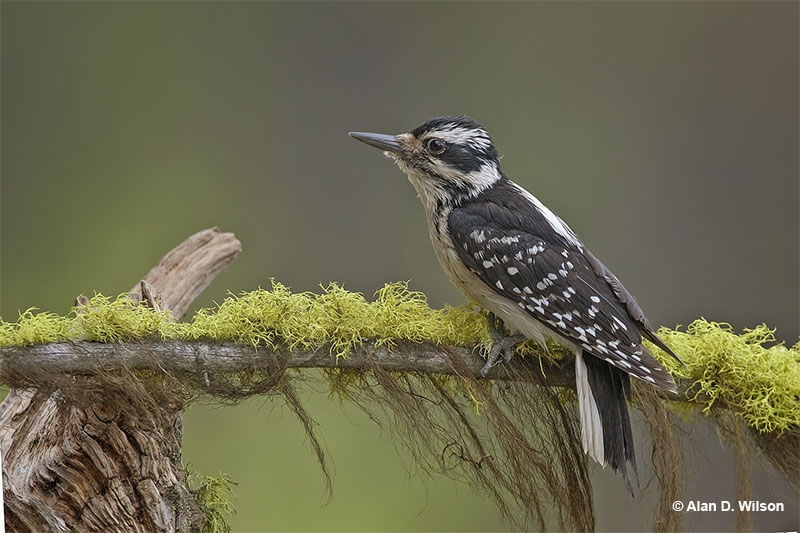
Hairy Woodpeckers may live longer as the few banded and recaptured birds have been 13 and 15 years old.
However, more is known about the factors that can affect how long Woodpeckers live. In good habitat, nestling Woodpeckers seem to live longer than Duck nestlings and many other small birds. Although some nestlings are caught by predators like snakes and squirrels, a high percentage survive to the fledgling stage.
As with many birds, the first year in the life of a Woodpecker is probably the most challenging one. Young birds at this stage are inexperienced and thus more vulnerable to predators, especially Sharp-shinned and Cooper’s Hawks. If they make a risky flight across a lake or other open area, they can also be caught by Merlins and Peregrine Falcons.
As long as they have enough food in good habitat, most Woodpeckers live long lives and have several young.
Downy vs Hairy Woodpecker Behavior
Both of these Woodpecker species spend much of their time hitching up tree trunks to look for food in a variety of wooded situations. They can peck both live and dead branches when foraging and also rapidly peck on a choice dead branch to delineate territory. This rapid pecking is typical for most Woodpecker species and is known as “drumming.”
Both species can also forage with other bird species in “mixed flock” situations although the Downy Woodpecker may do this more often, usually feeding with chickadees, nuthatches, and other small birds.
Neither species are particularly aggressive although they will drive off other woodpeckers of the same species from their territory. At feeders and other feeding situations, the Hairy Woodpecker can also dominate and chase away the smaller Downy Woodpecker.
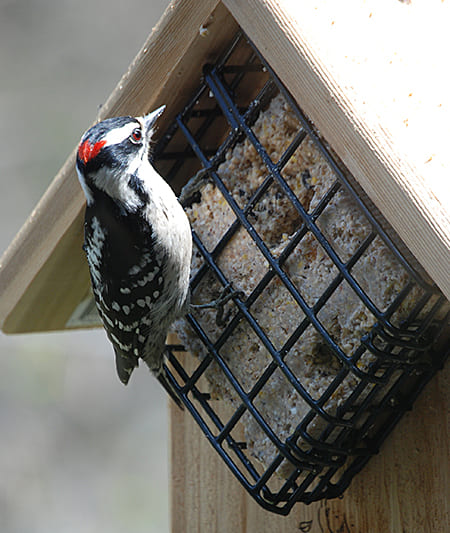
Downy Woodpecker at a feeder
As with many small birds, these Woodpeckers give alarm calls when they notice a predator and can help other small birds mob and harass roosting owls.
Neither of these Woodpecker species pose any threat to people or pets in any way.
Diet
Hairy and Downy Woodpeckers eat a wide variety of insects and insect larvae as well as some fruit and seeds. Both species also occasionally take sap but only drink it from holes already made by sapsuckers.
Both of these Woodpecker species forage by hitching up stems and tree trunks, and moving along branches to pick ants, beetles, and a wide variety of small insects off the surface of the bark. They also peck into live and dead trees and branches to search for the larvae of beetles and other wood-boring insects.
As with many other Woodpeckers, after Hairy and Downy Woodpeckers make holes in bark, they use their very long tongues to reach in, find, and extract the larvae.
Both of these species are also frequent visitors to bird feeders and will take various seeds. Most of all, they love to feed on “suet”, the hard fat from the loin and kidney regions of cattle and sheep.
However, there are differences in the ways these two similar species forage. Downy Woodpeckers search for food on thin stems, twigs, and in bushes, while Hairy Woodpeckers mostly forage on larger trees.
The Downy Woodpecker also eats smaller insects, including insects found in or just below the bark, whereas Hairy Woodpeckers can eat larger insects and bigger larvae that live deeper inside a tree.
Downy vs Hairy Woodpecker Location
Downy and Hairy Woodpeckers live in a similar variety of habitats that include coniferous and deciduous woodlands, forest, and, as long as enough big trees are present, public parks and gardens.
The Downy Woodpecker lives in wooded areas from Alaska to Canada and the lower 48 states except for arid parts of Texas and the American Southwest.
The Hairy Woodpecker occurs in forests in Alaska, much of Canada, and in large areas of the lower 48 states. It also lives on a few islands in the Bahamas, and in montane forests of Mexico and Central America.
No matter where they occur, in general, the Downy Woodpecker can live in more edge and urban habitats than the Hairy Woodpecker.
Nest & Eggs
The Downy Woodpecker lays four to six white eggs in a tree cavity excavated by both parents.
The cavity is usually located in a dead snag or dead branch, often on a live tree, and is anywhere from 15 to 30 feet above the ground. Both parents incubate the eggs for 12 days.
Eggs weigh 2.10 grams each, and the male does all of the incubating and brooding during the night. Both parents share those duties during the day.
The nest of the Hairy Woodpecker is similar but with a larger entrance hole and is usually excavated in a live tree, or in the underside of a branch affected by fungus.
The number of eggs laid, egg color, nest height, and incubation times are similar to those for the Downy Woodpecker, except Hairy Woodpecker eggs weigh 4.4 grams each.
Both parents share incubation duties but male Hairy Woodpeckers may or may not incubate and brood at night.
Keep reading: The Lives of Baby Woodpeckers
Downy vs Hairy Woodpecker: Frequently Asked Questions
What is the difference between Hairy and Downy Woodpeckers?
Hairy Woodpeckers are larger than Downy Woodpeckers and have a longer bill.
Are Downy and Hairy woodpeckers related?
Yes, but distantly related. Despite their similar appearance, Hairy and Downy Woodpeckers are not closely related.
What do Downy and Hairy Woodpecker sound like?
Downy Woodpeckers make a brief “check” call and high-pitched musical rattle. Hairy Woodpeckers make a sharper “peek” call and a more mechanical sounding, drier rattle.

